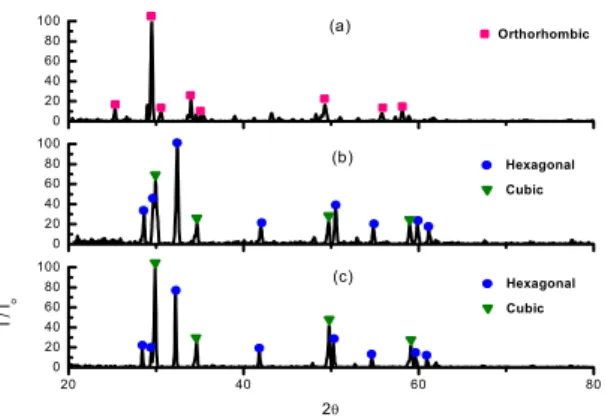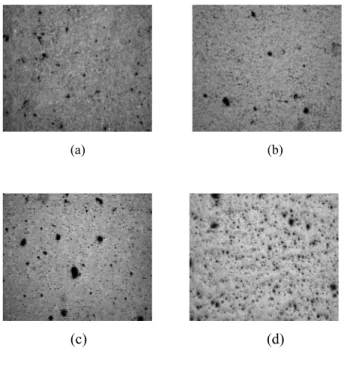1. Introduction
Currently, More than 60 ceramic absorber materials Based on Dy, Eu, Sm, Dy, Hf, Cd, pure Hf and Hf alloys have been examined with the purpose to replace (n,α)-ab -sorbers. Dysprosium titanate is an attractive control rod material for the thermal neutron reactors. Its main advantages are : insignificant swelling, no out-gassing under neutron irradiation, rather high neutron efficiency , a high melting point(~1870℃), non-interaction with the cladding at temperatures above 1000℃, simple fabrication and easily reprocessed non-radioactive waste. DyxTiyOz is a solid solution formed by sintering of Dy2O3-TiO2 compact. This solid solution has Dy dens-ity of 3.6 and 4.9 g/cm3 as a absorber material. [1][2]
The sinterability of Dy2O3+TiO2 mixed oxides was tested for various mixing ratios and sintering parameters.
Sintered density and XRD phases of DyxTiyOz pellets were evaluated in this study.
2. Experimental
The mixing ratio of Dy2O3/TiO2 was calculated according to the Dy density and sintered density of DyxTiyOz pellet. The weighed amount of both Dy2O3 and TiO2 was blended in a Turbula mixer for 1h, then milled by using Planetary mill with a zirconia jar containing 10mm zirconia balls at a rotation speed of 300rpm for 1h. The milled powder was pressed into cylindrical compacts using a double-acting hydraulic press under 300MPa. The campacts were sintered at 1650℃, 1500℃
and 1350℃ in air atmosphere for 4hr. Density of sintered pellet was measured by water immersion method. Ceramography of the pellets was done and pore structure was analyzed by using image analysis system on the polished sections. XRD on the pellet was analyzed by using Cu target(Kα 1.54056 ) with Å sampling width of 0.02degree and scanning speed of 4.00 deg/min.
3. Results 3.1 X-ray diffraction studies
The XRD patterns of DyxTiyOz with different sintering temperatures are shown in Fig. 1. It was obser -ved that Dy2TiO5 crystallize in an orthorhombic stru-cture at 1350℃ and hexagonal and cubic at 1500℃ and 1650℃. It was observed that Dy2TiO5(hexagonal) and Dy2Ti2O7 phases in the 4.00g Dy g/cm3 of DyxTiyOz sintered pellets(Fig.2). 20 40 60 80 0 20 40 60 80 100 0 20 40 60 80 100 0 20 40 60 80 100 (c) I / I o 2θ Hexagonal Cubic (b) Hexagonal Cubic (a) Orthorhombic
Fig. 1. XRD patterns of 4.88 Dy g/cm3 sintered pellets;
Phase study on the Dy
xTi
yO
zpellets.
Kim Jeong Seok†, Kim Han Soo, Jeong Chang Young,
Advanced Nuclear Fuel Department, Korea Atomic Energy Research Institute cera4@lycos.co.kr
Transactions of the Korean Nuclear Society Autumn Meeting Busan, Korea, October 27-28, 2005
(a) 1350℃, (b) 1500℃ , (c) 1650℃ 2 0 4 0 6 0 8 0 0 2 0 4 0 6 0 8 0 1 0 0 I / I o 2θ D y2T iO5(h a x a g o n a l) D y2T i2O7(p yro c h lo re )
Fig. 2. XRD patterns of DyxTiyOz pellet sintered at 1650℃
with Dy density of 4.00 Dy g/cm3.
3.2 Sinterability
Sintered density of 4.00g Dy g/cm3 and 4.88g Dy g/cm3of DyxTiyOz sintered pellets were 6.64 and 7.07 g/cm3 at 1650℃.
Fig. 3 shows micro-structures of the DyxTiyOz pellets sintered at different. There are a lot of white spots on the (b) and (c) micrographs. The amount of spots increases with sintering temperature. The XRD pattern of the DyxTiyOz shows the spots are Dy2TiO5 phase which has cubic crystal structure.
(a) (b)
(c) (d)
Fig. 3. Photos of microstructure ; 4.88 Dy g/cm3of Dy
xTiyOz
at (a) 1350℃, (b) 1500℃, (c) 1650℃and (d) 4.00
Dy g/cm3 at 1650℃
4. Conclusion
1. The white spots on the DyxTiyOz micrograph were cubic crystal of Dy2TiO5 phase.
2.. The spots increases with sintering temperature. 3. Phase transformation of DyxTiyOz is irreversible
dur-ing sinterdur-ing process..
Acknowledgment
This study was performed under the auspices of the Korea Ministry of Science and Technology.
Reference
[1] V. D. Risovany, E. E. Varlashova and D. N. Suslov, Dysprosium Titanate as an Absorber Material for Control Rod, J. Nucl. Mater, 281 84-9, 2000.
[2] G. Panneerselvam, R. Venkata Krishnan, M.P. Antonty, K. Nagarajan, T. Vasudevan, P.R. Vasudeva Rao, Thermophysical measurements on dysprosium and gadolinium titanates, Journal of nuclear materials, 327 p.220~225, 2004

